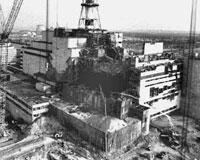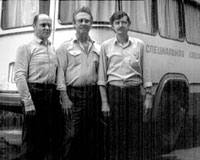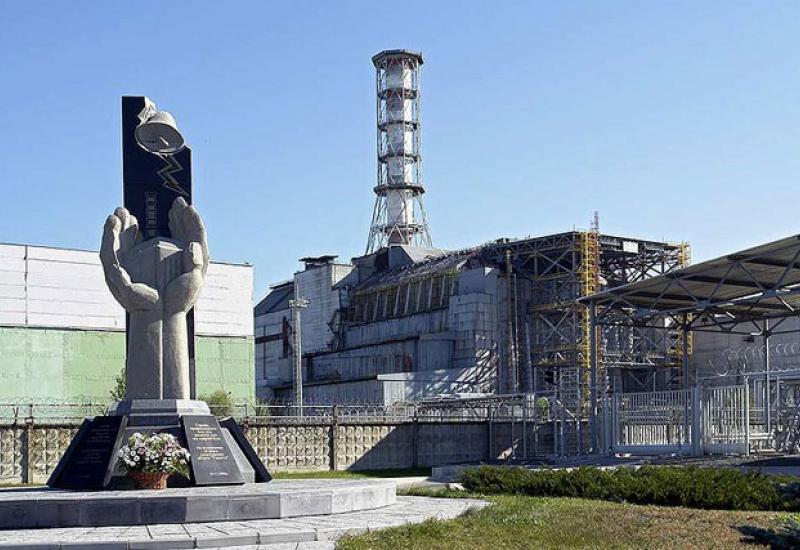On the first day of the accident, when the truth marked "Top Secret" has only received by the highest instance, and only a limited number of scientists to predict the possible consequences of the disaster, the insidious threat was approaching with fragrant warm breeze from the Polesie and abounding river water of Slavutych was approaching. But first radionuclides came to Kiev other way.
The dire consequences of the tragedy swept entire regions, many towns and villages, far from Chernobyl. Kiev in this list was in a special place. The fate of the city was not kidding. In case of excessive radioactive contamination of air, water, food in the city it would be a very difficult situation with the subsequent issue of the protection and possible evacuation of three millionth population. The probability of such development was very real, if not desperate resistance of the defenders of the capital of the raging elements as on the outskirts of Kiev, and in the city itself.
 Having learned from unofficial sources about the accident at a nuclear facility near Kiev, radiological services SES immediately issued recommendations to the district and other related services to strengthen control over the radiation background of the city. And after dinner, April 27, 1986 in the city there were found contaminated with radionuclides first cars. On the night of 27 April 28 thousand column of buses and trucks that were returning to Kiev after the evacuation of the city Pripyat, were stopped at the outskirts of the capital.
Having learned from unofficial sources about the accident at a nuclear facility near Kiev, radiological services SES immediately issued recommendations to the district and other related services to strengthen control over the radiation background of the city. And after dinner, April 27, 1986 in the city there were found contaminated with radionuclides first cars. On the night of 27 April 28 thousand column of buses and trucks that were returning to Kiev after the evacuation of the city Pripyat, were stopped at the outskirts of the capital.
On the morning of April 28 at an emergency meeting of the executive committee of the city the city’s leadership tried to find out who and why stopped the convoy of vehicles, hurried home to their automobile enterprises in time to reach the routes of the city. The explanations were given by an engineer-physicist of the radiation city service SES Ph.D. Y.A.Tatsiy. In the alarming information there was noted that unexpectedly and sooner than one might expect, there were documented cases of contamination with radionuclides vehicles and their level of pollution reaches hundreds of mR. The exploitation of such transport posed a real threat to the health of drivers and passengers. The route connecting Kiev with the Polesie region was contaminated, and traffic from this region leads to contamination with radionuclides streets of Kiev. 29-30 April, the city had recorded a sharp increase in background radiation.
Entry of contaminated transport in Kiev was prohibited. In nine areas in the city there were quickly established dosimetric posts and started the construction of settlements sanitization transport (sanitation post- SP). Responsibility for the construction of these facilities, the organization and conduct of decontamination measures rested with the headquarters Civil Defense of Kiev. For decontamination of transport there were used aqueous solutions of the corresponding SAR. In the course of this treatment on the posts there was accumulated a significant amount of contaminated water, that was temporarily collected in the ground or underground storage facilities. For cleaning contaminated water on SP it was assumed construction of the relevant stationary treatment facilities, which required at least two months time and jeopardize transport links to the area, which at any moment could be paralyzed, because the flow of contaminated transport grew, the number of water cleaning dramatically increased capacity and storage rings fill up quickly.
 Critical situation required extraordinary solutions. The leadership of Kyiv and headquarters CD sounded the alarm and were ready to consider any offers. And such a proposal came from KPI. A team of scientists from the FCT, namely O.P.Shutko, A.D.Krisenko and V.P.Basov suggested treatment technology of contaminated water, that did not require the creation of stationary treatment facilities. Decontamination of water was carried out directly in the storage volume with specially designed effective reagents. 1,5-2 hours after this treatment, radioactive materials sank to the bottom and supernatant water that meets the standards of MPC, was evacuated to the area or used for watering roads.
Critical situation required extraordinary solutions. The leadership of Kyiv and headquarters CD sounded the alarm and were ready to consider any offers. And such a proposal came from KPI. A team of scientists from the FCT, namely O.P.Shutko, A.D.Krisenko and V.P.Basov suggested treatment technology of contaminated water, that did not require the creation of stationary treatment facilities. Decontamination of water was carried out directly in the storage volume with specially designed effective reagents. 1,5-2 hours after this treatment, radioactive materials sank to the bottom and supernatant water that meets the standards of MPC, was evacuated to the area or used for watering roads.
It should be noted that the interest of the scientists KPI in the problem of sewage treatment from radionuclides, was not accidental. O.P.Shutko headed in the KPI laboratory reagent water treatment, and associated prof. A.D.Krisenko and V.P. Bass were the specialists in the practical work with open radioactive substances. All three of them defended their dissertations at the radiochemistry laboratory of the Department of Physical and Colloid Chemistry KPI. Therefore, determining the composition of the waste water nuclides (O.P.Shutko owned in the third decade of May radioactive water samples taken directly from the destroyed Chernobyl Unit), the group has developed a more effective formulation of reagents and designed the mobile unit for practical work in the field.
The Institute for Nuclear Research, USSR Academy of Sciences of Ukraine and the Institute of General and Communal Hygiene Ministry of Health has been verified the effectiveness of the proposed technology. Development was approved and recommended for use. With the support of staff CD of Kiev there was produced the first mobile automobile plant for cleaning the contaminated water. At the same time Rubezhnyi PA "Krasitel" according to transferred telephoto regulation there was produced the first batch of effective integrated reagent and immediately delivered to Kiev..
Field testing of the proposed technology demonstrated high efficiency. The degree of purification of polluted water reaches three orders of magnitude, by that time, and in the real world it was considered unattainable. The strain at the main SP in the northern direction of Kiev during two days was removed.
June 6, 1986 on the order of the Chief CD of Kiev at the city headquarters of the CD there was established the team for decontamination of water, consisting of experts KPI - authors design, drivers, instrument operators, compressors. It consisted of 11 people. Quality control of the purified water is provided by a SES of Kiev. Head of division was appointed O.P.Shutko, his deputies - A.D.Krisenko and V.P.Basov. In July 1986 in Kiev factory "Dormash" and "Stroydormash" it was created another upgraded mobile unit. Mobility and high performance systems (1000-1200 m3 of treated water at single loading reagent tank installation) satisfied the smooth functioning of all SP around Kiev. The relevant central headquarters for elimination the consequences of the collapse in Chernobyl and Belarus were interested in the development.
For 1986 and the end of 1987 there was created a division operated in the rapid response and planned to control SP of Kiev region, a 30-kilometer zone, in Belarus and points wash equipment South Western Railway. During this work it has been cleaned up to 50 m3 waters. Implementation of design and selfless work of specialists KPI allowed to save the state more than 18000000 rubles (in 1986 prices.). In addition, it was no longer necessary the creation of stationary treatment facilities at SP, which, by the way, should become a lifelong radioactive burials. Construction of these facilities was stopped and inhibited.
The decision of the Government Commission elements of the proposed technology and progressive experience in Kiev have been used SP in the 30-kilometer zone of Chernobyl, and mobile installations, developed by experts of the KPI, were introduced into regiments and divisions CD of USSR. They were used in Belarus. In order to clean the wash water rail transport at the station. Vilcha YUZZHD there was built and worked rolling stock. Its design and construction was also attended by scientists KPI.
The work of this department was written in the newspaper "Pravda" from 15.08.1986, and "Pravda Ukrainy" from 12.17.1986. In 1987, the development of scientists has been awarded a gold, silver and bronze medals the main exhibition of USSR, and in 1989 it was nominated for the State Prize of Ukraine in the field of science and technology.
Today, on the eve of the 20th anniversary of the Chernobyl accident, analyzing the results of the group's work in those heady days, we can say that if it was possible not just to close one of the ways of contamination with radionuclides of the city, but to change the strategy of protection. In addition to significant savings in material and financial resources, it has been preserved (and this is - most importantly!) the health and lives of hundreds of people who were planning to send into the core of the construction, commissioning and maintenance of sewage treatment plants.

